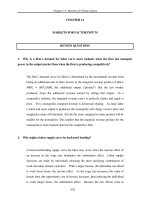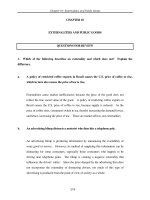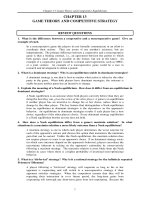Tài liệu Câu hỏi đánh giá môn Kinh tế vĩ mô bằng tiếng Anh- Chương 7 docx
Bạn đang xem bản rút gọn của tài liệu. Xem và tải ngay bản đầy đủ của tài liệu tại đây (64.73 KB, 7 trang )
Chapter 7: The Costs of Production
84
CHAPTER 7
THE COST OF PRODUCTION
QUESTIONS FOR REVIEW
1. A firm pays its accountant an annual retainer of $10,000. Is this an economic cost?
Explicit costs are actual outlays. They include all costs that involve a
monetary transaction. An implicit cost is an economic cost that does not
necessarily involve a monetary transaction, but still involves the use of
resources. When a firm pays an annual retainer of $10,000, there is a
monetary transaction. The accountant trades his or her time in return for
money. Therefore, an annual retainer is an explicit cost.
2. The owner of a small retail store does her own accounting work. How would you
measure the opportunity cost of her work?
Opportunity costs are measured by comparing the use of a resource with its
alternative uses. The opportunity cost of doing accounting work is the time
not spent in other ways, i.e., time such as running a small business or
participating in leisure activity. The economic, or opportunity, cost of doing
accounting work is measured by computing the monetary amount that the
owner’s time would be worth in its next best use.
3. Please explain whether the following statements are true or false.
Formatted: Font: Times New
Roman, 13 pt
Formatted: Space Before: 1.2 line,
After: 1.2 line, Line spacing: 1.5
lines
Chapter 7: The Costs of Production
85
a. If the owner of a business pays himself no salary, then the accounting cost is
zero, but the economic cost is positive.
True. Since there is no monetary transaction, there is no accounting, or
explicit, cost. However, since the owner of the business could be employed
elsewhere, there is an economic cost. The economic cost is positive,
reflecting the opportunity cost of the owner’s time. The economic cost is
the value of the next best alternative, or the amount that the owner would
earn if he took the next best job.
b. A firm that has positive accounting profit does not necessarily have positive
economic profit.
True. Accounting profit considers only the explicit, monetary costs. Since
there may be some opportunity costs that were not fully realized as explicit
monetary costs, it is possible that when the opportunity costs are added in,
economic profit will become negative. This indicates that the firm’s
resources are not being put to their best use.
c. If a firm hires a currently unemployed worker, the opportunity cost of
utilizing the worker’s services is zero.
False. The opportunity cost measures the value of the worker’s time, which
is unlikely to be zero. Though the worker was temporarily unemployed, the
worker still possesses skills, which have a value and make the opportunity
cost of hiring the worker greater than zero. In addition, since opportunity
cost is the equivalent of the worker’s next best option, it is possible that the
worker might have been able to get a better job that utilizes his skills more
efficiently. Alternatively, the worker could have been doing unpaid work,
Formatted: Bullets and Numbering
Formatted: Bullets and Numbering
Deleted: This is
Deleted: and
Deleted: s
Deleted: considered
Deleted: Subtracting extra costs could
make the profit negative, in economic
terms.
Deleted: not
Deleted:
p
ossesses certain
Chapter 7: The Costs of Production
86
such as care of a child or elderly person at home, which would have had a
value to those receiving the service.
4. Suppose that labor is the only variable input to the production process. If the
marginal cost of production is diminishing as more units of output are produced,
what can you say about the marginal product of labor ?
The marginal product of labor must be increasing. The marginal cost of
production measures the extra cost of producing one more unit of output. If
this cost is diminishing, then it must be taking fewer units of labor to
produce the extra unit of output, since the extra cost refers to the extra cost
of the labor. If fewer units of labor are required to produce a unit of output,
then the marginal product (extra output produced by an extra unit of labor)
must be increasing. Note also, that MC=w/MPL, so that if MC is
diminishing then MPL must be increasing for any given w.
5. Suppose a chair manufacturer finds that the marginal rate of technical substitution
of capital for labor in his production process is substantially greater than the ratio of
the rental rate on machinery to the wage rate for assembly-line labor. How should he
alter his use of capital and labor to minimize the cost of production?
To minimize cost, the manufacturer should use a combination of capital and
labor so the rate at which he can trade capital for labor in his production
process is the same as the rate at which he can trade capital for labor in
external markets. The manufacturer would be better off if he increased his
use of capital and decreased his use of labor, decreasing the marginal rate of
technical substitution, MRTS. He should continue this substitution until his
Formatted: Bullets and Numbering
Deleted: (the variable input)
Deleted: rising
Chapter 7: The Costs of Production
87
MRTS equals the ratio of the rental rate to the wage rate. The MRTS in this
case is equal to MPK/MPL. As the manufacturer uses more K and less L, the
MPK will diminish and the MPL will increase, both of which will decrease
the MRTS until it is equal to the ratio of the input prices (rental rate on capital
divided by wage rate).
6. Why are isocost lines straight lines?
The isocost line represents all possible combinations of labor and capital that
may be purchased for a given total cost. The slope of the isocost line is the
ratio of the input prices of labor and capital. If input prices are fixed, then
the ratio of these prices is clearly fixed and the isocost line is straight. Only
when the ratio or factor prices change as the quantities of inputs change is the
isocost line not straight.
7. Assume the marginal cost of production is increasing. Can you determine
whether the average variable cost is increasing or decreasing? Explain.
Marginal cost can be increasing while average variable cost is either
increasing or decreasing. If marginal cost is less (greater) than average
variable cost, then each additional unit is adding less (more) to total cost than
previous units added to the total cost, which implies that the AVC declines
(increases). Therefore, we need to know whether marginal cost is greater
than average variable cost to determine whether the AVC is increasing or
decreasing.
8. Assume the marginal cost of production is greater than the average variable cost.
Can you determine whether the average variable cost is increasing or decreasing?
Explain.
Chapter 7: The Costs of Production
88
If the average variable cost is increasing (decreasing), then the last unit
produced is adding more (less) to total variable cost than the previous units
did, on average. Therefore, marginal cost is above (below) average variable
cost. In fact, the point where marginal cost exceeds average variable cost is
also the point where average variable cost starts to rise.
9. If the firm’s average cost curves are U-shaped, why does its average variable cost
curve achieve its minimum at a lower level of output than the average total cost
curve?
Total cost is equal to fixed plus variable cost. Average total cost is equal to
average fixed plus average variable cost. When graphed, the difference
between the U-shaped total cost and average variable cost curves is the
average fixed cost curve. Thus, falling average variable cost and average
fixed cost sum up to a falling average total cost curve. Since average fixed
cost continues to fall as more output is produced, average total cost will
continue to fall even after average variable cost has reached its minimum
because the drop in average fixed cost exceeds the increase in the average
variable cost. Eventually, the fall in average fixed cost becomes small
enough so that the rise in average variable cost causes average total cost to
begin to rise.
10. If a firm enjoys economies of scale up to a certain output level, and then cost
increases proportionately with output, what can you say about the shape of the long-
run average cost curve?
When the firm experiences increasing returns to scale, its long-run average
cost curve is downward sloping. When the firm experiences constant returns
to scale, its long-run average cost curve is horizontal. If the firm experiences
Formatted: Bullets and Numbering
Chapter 7: The Costs of Production
89
increasing returns to scale, then constant returns to scale, its long-run average
cost curve falls, then becomes horizontal.
11. How does a change in the price of one input change the firm’s long-run
expansion path?
The expansion path describes the combination of inputs that the firm chooses
to minimize cost for every output level. This combination depends on the
ratio of input prices: if the price of one input changes, the price ratio also
changes. For example, if the price of an input increases, less of the input can
be purchased for the same total cost, and the intercept of the isocost line on
that input’s axis moves closer to the origin. Also, the slope of the isocost
line, the price ratio, changes. As the price ratio changes, the firm substitutes
away from the now more expensive input toward the cheaper input. Thus,
the expansion path bends toward the axis of the now cheaper input.
12. Distinguish between economies of scale and economies of scope. Why can one
be present without the other?
Economies of scale refer to the production of one good and occur when
proportionate increases in all inputs lead to a more-than-proportionate
increase in output. Economies of scope refer to the production of more than
one good and occur when joint output is less costly than the sum of the costs
of producing each good or service separately. There is no direct relationship
between increasing returns to scale and economies of scope, so production
can exhibit one without the other. See Exercise (14) for a case with constant
product-specific returns to scale and multiproduct economies of scope.
13. Is the firm’s expansion path always a straight line?
Formatted: Bullets and Numbering
Chapter 7: The Costs of Production
90
No. If the long run expansion path is a straight line this means that the firm
always uses capital and labor in the same proportion. If the capital labor
ratio changes as output is increased then the expansion path is not a straight
line.
14. What is the difference between economies of scale and returns to scale?
Economies of scale measures the relationship between cost and output, i.e.,
when output is doubled, does cost double, less then double, or more than
double. Returns to scale measures what happens to output when all inputs
are doubled.
economies of scope.
Formatted: Bullets and Numbering
Deleted: Also, in the short run the
expansion path may be horizontal if
capital is fixed.
Deleted: what happens to
Deleted: when outpu
Deleted: t is doubled.









